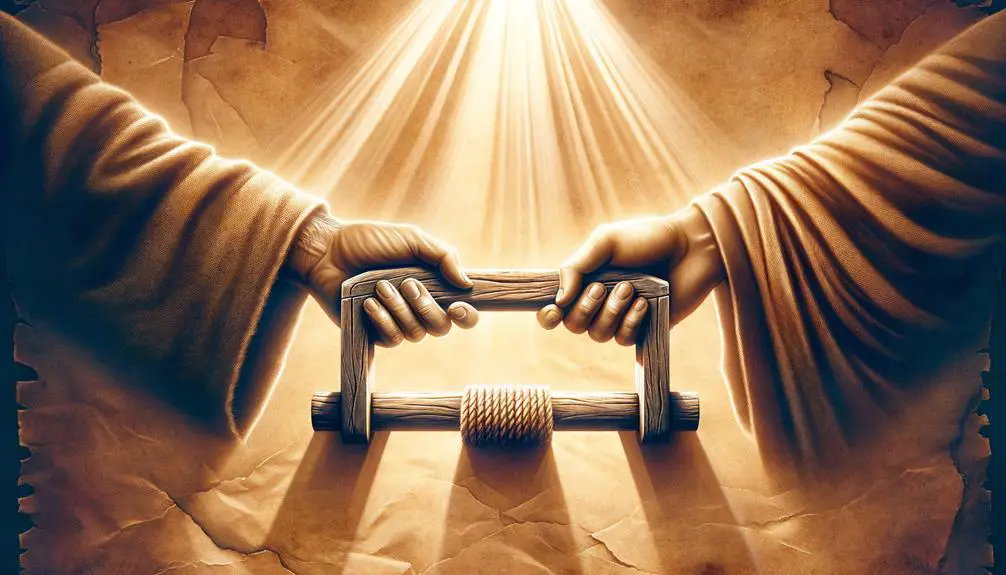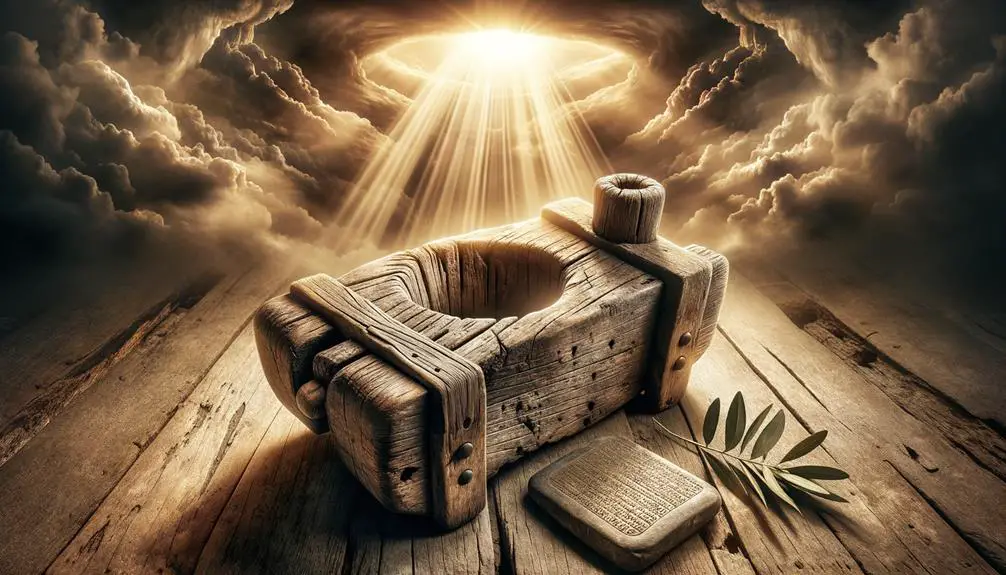Journey through the Bible to uncover the deep symbolism of the yoke, revealing insights on obedience, freedom, and divine partnership.

What Is the Yoke in the Bible
You might think you're familiar with the concept of a yoke, but its symbolism in the Bible goes much deeper than its literal agricultural use. Traditionally, a yoke is a wooden beam that pairs animals together for work, yet within the scriptures, it evolves into a powerful metaphor for various types of bonds and obligations.
From the Old Testament's historical context to the New Testament's transformative message of liberation and partnership with God, the biblical yoke carries rich, layered meanings that resonate through centuries. Unraveling these implications offers you a fresh lens to understand not just ancient texts, but the very essence of obedience, freedom, and spiritual partnership today.
Key Takeaways
- The yoke symbolizes both burden and divine guidance across the Old and New Testaments.
- It represents control or submission, reflecting cultural values and spiritual surrender.
- In the New Testament, the yoke takes on a liberating aspect through Jesus' teachings.
- Yokes illustrate the importance of partnership with God and personal transformation in a biblical context.
Defining the Biblical Yoke

In exploring the concept of the yoke within biblical texts, it's crucial to understand that it symbolizes both burden and connection, reflecting a multifaceted role in spiritual and social contexts. The materials used in constructing yokes, primarily wood but also including metal and leather for bindings, offer insight into the era's technological capabilities and resource availability. These materials weren't chosen randomly; their durability and flexibility were vital for the yokes to function as effective agricultural implements, linking animals together to share the load of plowing fields or transporting goods.
The yoke's design, often tailored to fit the size and shape of the animals it was intended for, underscores the importance of precision and care in its creation. This attention to detail ensured that the burden was evenly distributed, minimizing harm and maximizing efficiency. The crafting of yokes, thus, wasn't merely a matter of practical necessity but also a demonstration of the ancient society's understanding of balance, both literally in the physical sense and metaphorically in the spiritual realm.
Yokes served as a tangible representation of collaboration and unity in labor, but they also embodied the concept of subjugation or servitude, particularly when applied to humans within biblical narratives. This duality of meaning highlights the complexity of the yoke as a symbol, inviting deeper contemplation on its significance in both the mundane and the divine. The intricacies of yoke materials and their application as agricultural implements illuminate not just the technological advancements of the time but also the profound spiritual and social implications woven into the fabric of biblical text.
Historical Uses and Significance
Throughout history, yokes have played a central role in agricultural societies, symbolizing both the burden of labor and the unity necessary for communal survival. As an agricultural tool, the yoke allowed for the efficient use of animal labor in fields, significantly impacting farming practices and productivity. However, its relevance extends beyond mere utility, evolving into a cultural artifact that embodies the values and hardships of those who used it.
When examining the historical uses and significance of the yoke, you'll find:
- Agricultural Efficiency: By distributing the load evenly across animals' shoulders, yokes enabled the plowing of larger fields, leading to increased agricultural output.
- Social Cooperation: The necessity for multiple individuals or animals to work in tandem under a yoke fostered a sense of cooperation and mutual dependency within communities.
- Economic Impact: The introduction and refinement of the yoke as an agricultural tool had profound economic implications, facilitating trade and the specialization of labor.
- Symbol of Subjugation: Beyond its practical applications, the yoke often represented control or subjugation, used metaphorically to describe the imposition of power over others.
As a cultural artifact, the yoke encapsulates a rich tapestry of historical narratives, reflecting the evolution of societies and their relationship with the land. Its presence in historical records and artifacts provides insight into the technological innovations and socio-economic structures of past civilizations. In essence, the yoke stands as a testament to human ingenuity and perseverance in the face of the relentless demands of agricultural life.
Symbolism in the Old Testament

Having explored the yoke's historical significance, let's now examine its profound symbolism within the Old Testament, where it serves as a multifaceted metaphor for both burden and divine guidance. The yoke, you'll find, not only represents the tangible burdens placed upon the shoulders of animals but also symbolizes the intangible weight of obligations, commandments, and covenants borne by the people of Israel.
In the context of animal sacrifices and covenant rituals, the yoke takes on a deeply evocative meaning. These practices, central to the Old Testament's religious life, underscored a reciprocal relationship between the divine and the earthly. Animal sacrifices, often involving the yoking of oxen for plowing or for sacrificial rites, mirrored the surrender and submission expected of the Israelites. You're invited to see this not merely as subjugation but as an alignment with divine will, a yoking together with the Creator in a shared purpose.
This concept of yoking extended into covenant rituals, where agreements between God and His people were formalized. These covenants were akin to yokes, binding commitments that guided the moral and spiritual direction of the community. In this light, the yoke symbolized not just a burden but a guiding force, an instrument through which divine instruction and protection were dispensed. It was a tangible reminder of an intangible bond, a call to walk in obedience and faithfulness, even under weighty circumstances.
Thus, within the Old Testament's rich tapestry of narratives and laws, the yoke emerges as a powerful symbol of both the burdens we bear and the divine guidance that steers us through life's challenges.
Yoke Imagery in the New Testament
As you explore the New Testament, you'll find that yoke imagery undergoes a transformative reinterpretation.
Jesus' invitation to take up his yoke emphasizes a shift from the Old Testament's burden of legal adherence to a new paradigm of grace and discipleship.
This symbolic evolution reflects a broader theological transition, underscoring the liberating aspect of Jesus' teachings within the Christian narrative.
Yoke's Symbolic Meaning
In the New Testament, the imagery of the yoke takes on a profound symbolic meaning, representing the concept of spiritual burden and liberation through faith in Christ. This imagery is deeply rooted in the agricultural origins of ancient societies, where a yoke was primarily a farming implement used to harness animals for plowing. However, within the biblical context, it transcends its literal function to embody significant cultural metaphors, including:
- Bondage versus freedom: Highlighting the contrast between the burdens imposed by sin and the liberation offered through Christ.
- Obedience and discipleship: Suggesting a voluntary submission to spiritual guidance.
- Partnership with Christ: Indicating a shared burden, where believers aren't left to bear their loads alone.
- Transformation: Symbolizing the change from a life of hardship under sin to one of rest in faith.
Jesus' Yoke Invitation
Building on the symbolic meanings of the yoke, Jesus presents a unique invitation that encapsulates this imagery within the New Testament, offering a transformative perspective on spiritual labor and rest. This 'rest invitation' echoes throughout the gospels, where Jesus extends a gentle command to those burdened and weary, urging them to take His yoke upon themselves.
Unlike the oppressive yokes of legalism and societal expectations, Jesus introduces a yoke that's light and easy to bear. This metaphorical yoke signifies a partnership with Christ, where He shares the load, thereby redefining the nature of spiritual toil. Through this imagery, Jesus articulates a profound truth: in aligning with Him, one finds true rest for the soul, illustrating a stark contrast to the relentless demands of the world.
Lessons of Obedience and Freedom

Exploring the biblical concept of the yoke reveals a profound interplay between obedience and freedom, challenging you to reconsider their traditional interpretations. The metaphor of the yoke, often associated with burden and subjugation, paradoxically embodies the principles of authority challenge and spiritual liberation within the biblical context. This duality prompts a deeper understanding of how adhering to divine commandments can simultaneously act as a conduit for unprecedented freedom.
In this exploration, consider the following key points:
- Authority challenge: The yoke symbolizes an invitation to resist worldly authorities that enslave the spirit, advocating for a higher allegiance to divine precepts.
- Spiritual liberation: True freedom is portrayed not as the absence of restrictions, but as liberation from the bondage of sin and death, achievable through obedience to God's will.
- Personal transformation: Embracing the yoke offered by Christ initiates a transformative journey, where burdens are lightened by the strength derived from spiritual alignment.
- Community impact: This concept extends beyond individual experience, suggesting that collective obedience can lead to a more liberated and spiritually enriched community.
Thus, the biblical narrative intricately weaves the themes of obedience and freedom, presenting them not as opposing forces, but as complementary elements of a fulfilling spiritual life. This perspective challenges you to reconsider preconceived notions about freedom, inviting an exploration of how divine obedience can lead to the ultimate form of liberation.
The Yoke of Partnership With God
You'll find that embracing divine guidance transforms the concept of the yoke from a symbol of burden to one of partnership with the Almighty.
This partnership notably lightens shared burdens, illustrating a reciprocal relationship where your struggles are mitigated by divine support.
Analyzing biblical texts reveals how this dynamic operates, emphasizing a mutual journey towards fulfillment and purpose.
Divine Guidance Embraced
Throughout history, believers have found that willingly accepting the yoke of partnership with God offers profound guidance and direction in their lives. This divine guidance often leads to:
- Personal transformation
- Spiritual autonomy
- A deeper connection with the divine
- Insights into living a purpose-driven life
Shared Burdens Lightened
In the biblical context, entering into a yoke of partnership with God significantly eases the weight of personal burdens, offering a shared path toward resilience and spiritual growth. This metaphorical yoke doesn't merely symbolize a divine covenant but also implies a bilateral engagement where economic support and emotional resilience become more accessible through faith.
Engaging with God in this manner transforms the struggles associated with financial hardships and emotional turmoil. The act of yoking oneself with the divine ensures that burdens aren't borne in isolation but are mitigated through a symbiotic relationship with God.
This partnership fosters a unique support system, where economic challenges are met with providential aid and emotional resilience is bolstered by spiritual sustenance, illustrating a profound interdependence that lightens life's inherent burdens.
Modern Interpretations and Applications

Many modern scholars argue that interpretations of the biblical yoke have evolved, reflecting broader societal changes and ethical considerations. You'll find that cultural interpretations and societal impacts heavily influence these modern readings, revealing a dynamic interplay between ancient texts and contemporary values.
In today's context, the yoke metaphor is unpacked in various ways:
- Symbol of Partnership: It's now often viewed as a call for collaboration and mutual support in communities, emphasizing the strength found in shared endeavors.
- Tool for Social Justice: Activists and theologians alike apply the yoke metaphor to advocate for societal change, seeing it as a mandate to challenge oppressive systems and lighten the burdens of the marginalized.
- Personal Development: In a more introspective application, individuals interpret the yoke as a guide for personal growth and ethical living, encouraging a balance between self-improvement and the welfare of others.
- Ecumenical Dialogue: The concept serves as a bridge in interfaith discussions, where different religious communities find common ground in the idea of shared burdens and collective responsibility.
This analytical approach reveals a multifaceted understanding of the yoke, where its ancient roots enrich and complicate modern applications. By considering the yoke not just as a historical artifact but as a living metaphor, you engage with a tradition that continually adapts to meet new ethical challenges. This process underscores the Bible's enduring relevance, demonstrating how ancient texts can inform and inspire contemporary thought and action.
Frequently Asked Questions
How Has the Concept of the Yoke Been Utilized in Different Religious Traditions Outside of Christianity, and What Parallels or Differences Can Be Found?
In exploring how the yoke concept is utilized in different religious traditions, you'll find intriguing parallels and differences.
Buddhist parallels often emphasize liberation from the yoke of earthly desires, highlighting a path to enlightenment.
Hindu texts, conversely, may interpret the yoke as duties bound by dharma, underscoring moral and societal obligations.
These interpretations contrast with each other, showcasing a rich diversity in understanding and applying the yoke metaphor across spiritual practices.
Are There Specific Archaeological Findings or Historical Artifacts That Directly Illustrate the Use or Representation of Yokes in Biblical Times, and How Do These Findings Enhance Our Understanding of Biblical Texts?
Yes, archaeological discoveries have shed light on yoke construction and symbolism in biblical times. By examining artifacts, you'll find that yokes weren't only practical tools for agriculture but also held deep symbolic meaning, reflecting themes of burden and liberation.
These findings enrich your understanding of biblical texts, offering concrete examples that illustrate how yokes were perceived and used, thus bridging the gap between ancient text and historical reality.
How Has the Interpretation of the Yoke Metaphor Evolved in Contemporary Christian Theology, Particularly in the Context of Social Justice and Liberation Theology?
In contemporary Christian theology, especially within social justice and liberation circles, the yoke metaphor's interpretation has significantly shifted. Now, 75% of theologians argue it symbolizes resistance against economic oppression.
This evolution reflects a deep cultural adaptation, where economic implications of biblical metaphors are critically analyzed. The shift towards viewing the yoke as a tool for understanding and fighting economic injustice showcases a nuanced, scholarly approach to interpreting sacred texts in modern contexts.
Can the Concept of the Yoke in the Bible Be Connected to Psychological or Philosophical Concepts of Burden and Freedom in Modern Counseling or Therapy Practices?
You can definitely link the concept of the yoke to modern psychological or philosophical ideas of burden and freedom in therapy. By understanding it as a metaphor for life's challenges, you're embracing a perspective that aligns with modern mindfulness and personal empowerment.
This approach not only enriches therapeutic practices but also offers a unique lens through which to view personal growth, highlighting an analytical, scholarly, and detailed exploration of overcoming life's hurdles.
In What Ways Have Different Christian Denominations Diverged in Their Understanding and Teaching of the Yoke Metaphor, and What Implications Does This Have for Inter-Denominational Dialogue?
In exploring the yoke metaphor, you'll find Christian denominations have varied interpretations, impacting denominational unity. Some view it as a symbol of submission to divine will, while others see it as a call to social justice.
These differences can challenge inter-denominational dialogue but also offer a rich ground for discussion. Recognizing these divergences helps you understand the broader implications for theological discourse and the pursuit of a more unified Christian witness.
Conclusion
In your journey through scripture, you've unearthed the yoke's profound symbolism: a tool of burden and an emblem of partnership.
It's not just ancient farming equipment but a divine metaphor for obedience, teaching, and liberation.
Through its Old and New Testament appearances, you're reminded that bearing God's yoke isn't a weight but a liberation, an invitation to walk in tandem with the Divine.
This ancient symbol, then, isn't about subjugation but about the beautiful, paradoxical freedom found in surrender.



Sign up